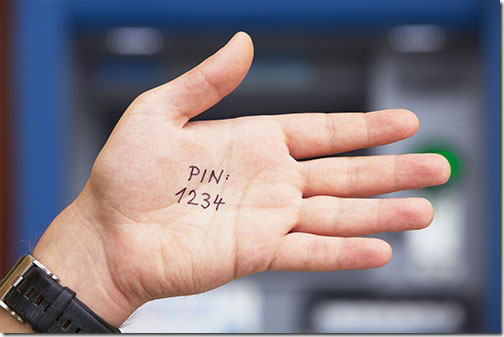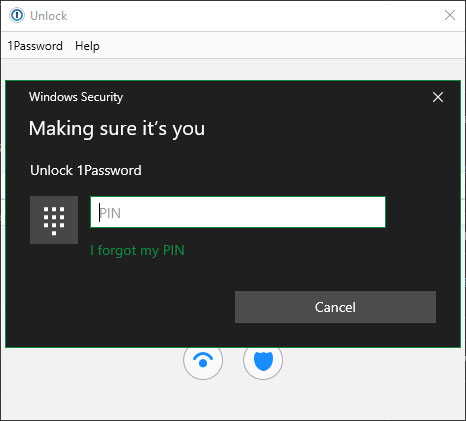Use a PIN or password more secure on Windows 10?
In Windows 10, Microsoft offers several ways to log in to a user account in addition to the standard password, including facial recognition and fingerprint scanning, but these are not available on some devices.
However, anyone can use a PIN (Personal Identification Number - personal identification number) to protect their Windows 10 account. Doing so is a great idea.
Let's look at the difference between a PIN and a password in Windows 10, as well as which option you should use in the following article.
PIN is unique for each device
 PIN is unique for each device
PIN is unique for each device The best security feature of Windows 10 PIN is that it only applies to one device. It is only used on your computer and never transferred to Microsoft servers. Therefore, if you put a PIN on your home PC and someone steals it, that person will not be able to access your account unless you have physical access to the device. Also, the PIN cannot log in to the Microsoft account the same as the password.
Using a Microsoft password to log in to a PC is actually more risky. If you must enter that password to log in every time, you will most likely choose a simple and weak password. If someone steals this password, they can also log into your Outlook email, Xbox account or any other number of Microsoft services you currently have.
Please use a combination of strong PIN and password
If you have used the password manager to set a secure password for your Microsoft account, then it may be very complicated to enter the password each time you log in. Signing in with a PIN will solve this problem, just make sure you use a good pin.
The recommendation for most people is to set a strong password for the Microsoft account and combine it with a good PIN to log in to the computer. This keeps your Microsoft account protected and allows you to log in to your PC conveniently (if you use two-factor authentication on your Microsoft account for even more security, that's great. ).
There are no disadvantages when setting up a PIN. Local account users can also set a PIN and apply the same rule. Because the local account only applies to your specific computer, the PIN is simply an alternative means of login. It does not bring the benefits of hiding your Microsoft account password.
Note that you can use a PIN when connecting to a PC via Remote Desktop and enter the PIN to log in using Safe Mode. Make sure you still have a handy standard password for those situations.
Use the PIN to log in to the application
As an added benefit, several supported Windows applications use Windows Hello to approve access to sensitive information, including 1Password and Google Chrome.
For example, after logging into 1Password with your one-time password, you can enter your PIN to unlock the app the next time. And Chrome now allows you to enter your PIN to automatically fill in saved credit card details into the form.
 After logging in to 1Password with your one-time password, you can enter your PIN to unlock the application the next time.
After logging in to 1Password with your one-time password, you can enter your PIN to unlock the application the next time. Entering a PIN is more convenient than entering a long password each time, so these connections are worth establishing. Just be aware that the level of security they provide is just as strong as your PIN.
Now that you know how the PIN works in Windows 10. When you log in to Windows, the system prompts you to enter a PIN instead of a password. To sign in with the alternate password, find the Sign-in options link below the text entry field.
TipsMake.com recommends that everyone set up a Windows 10 PIN, regardless of whether or not you use a Microsoft account. If you also want to secure your phone, see the pros and cons of using fingerprints or a PIN to lock your smartphone.
You should read it
- Instructions for changing Windows passwords without having to remember the old password
- How to set a password for a Windows 8 / 8.1 computer
- How to crack Windows 10 password, how to break password on Windows 10
- Set BIOS and UEFI password to protect data on your Windows 10 computer safely
- How to remove PDF file password
- Instructions on how to login to your computer when you forget your password
- Check the security of the password
- Use images instead of passwords - Should I use them?
May be interested
- How to set an app password on Windows 10
 for those who use the same computer, setting a password for the application is essential because they help improve security for the device. windows 10 operating system today has a lot of applications that support super secure password.
for those who use the same computer, setting a password for the application is essential because they help improve security for the device. windows 10 operating system today has a lot of applications that support super secure password. - Some security methods for online services
 online accounts such as facebook, email, messenger, etc. all now become targets for account steals, as they can quickly steal your personal data in just a few minutes. sleepy so how to keep safe when online?
online accounts such as facebook, email, messenger, etc. all now become targets for account steals, as they can quickly steal your personal data in just a few minutes. sleepy so how to keep safe when online? - How to secure Google Drive with password, Face ID
 google drive offers a security solution called privacy screen, like face id or fingerprint unlock, even before drive files appear, this feature enables a second lock screen for the app.
google drive offers a security solution called privacy screen, like face id or fingerprint unlock, even before drive files appear, this feature enables a second lock screen for the app. - 5 best password management apps for iOS
 password management application helps users to easily create secure passwords with high security for all online accounts, manage and store them in a systematic way and even inform you. if the password is leaked.
password management application helps users to easily create secure passwords with high security for all online accounts, manage and store them in a systematic way and even inform you. if the password is leaked. - Microsoft uses images as passwords for Windows 8
 microsoft revealed that one of the latest improvements in windows 8 is the 'picture password' feature, which uses images to secure computers.
microsoft revealed that one of the latest improvements in windows 8 is the 'picture password' feature, which uses images to secure computers. - How to set a password for Windows 10 computer, how to change Windows 10 password
 setting a computer password will help secure your computer better. in addition to setting a new password for your computer, tipsmake.com.com will also guide you how to change your windows 10 computer password. stay tuned.
setting a computer password will help secure your computer better. in addition to setting a new password for your computer, tipsmake.com.com will also guide you how to change your windows 10 computer password. stay tuned. - How to set a computer password on Windows 10,8,7
 if you don't know how to set a computer password, you can immediately refer to this tipsmake article. with detailed steps to help you set a secure computer password
if you don't know how to set a computer password, you can immediately refer to this tipsmake article. with detailed steps to help you set a secure computer password - How to create a safe, secure password
 to avoid account theft, or being impersonated ... you need to know how to set a strong password for each of your accounts.
to avoid account theft, or being impersonated ... you need to know how to set a strong password for each of your accounts. - Set up a secure password system
 most users who log on to their local pc or remote computers often use a combination of username and a password entered from the keyboard. so finding a good password and imposing a measure
most users who log on to their local pc or remote computers often use a combination of username and a password entered from the keyboard. so finding a good password and imposing a measure - How to turn off the Win 10 password - Uninstall and delete the Windows 10 password
 how to turn off the win 10 password - remove and delete the windows 10 password. if your computer does not need to be secure or you do not want to lose time each time you log in the computer to enter the password, then remove the password. password is essential.
how to turn off the win 10 password - remove and delete the windows 10 password. if your computer does not need to be secure or you do not want to lose time each time you log in the computer to enter the password, then remove the password. password is essential.










 Google shares the source code of Tsunami, an enterprise vulnerability scanning tool
Google shares the source code of Tsunami, an enterprise vulnerability scanning tool Security threats in VoIP
Security threats in VoIP How to help your facebook account get rid of hackers
How to help your facebook account get rid of hackers Docker Hub is used by hackers to spread Cryptojacking malware
Docker Hub is used by hackers to spread Cryptojacking malware How to find open and blocked TCP / UDP ports
How to find open and blocked TCP / UDP ports Set up Windows Server 2016 with a static IP address
Set up Windows Server 2016 with a static IP address